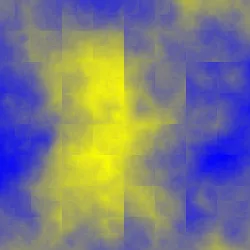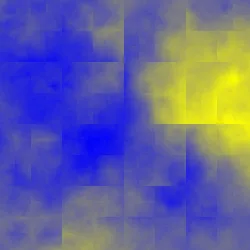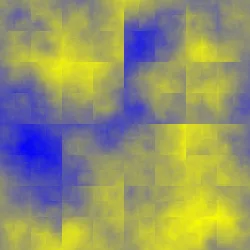我首先想到的是随机位移分形。它也可以用于生成地形,比Perlin噪声更容易。
package so;
import java.util.Random;
public class Noise {
private Random rand_;
float roughness_;
private float[][] grid_;
public Noise(Random rand, float roughness, int width, int height) {
roughness_ = roughness / width;
grid_ = new float[width][height];
rand_ = (rand == null) ? new Random() : rand;
}
public void initialise() {
int xh = grid_.length - 1;
int yh = grid_[0].length - 1;
grid_[0][0] = rand_.nextFloat() - 0.5f;
grid_[0][yh] = rand_.nextFloat() - 0.5f;
grid_[xh][0] = rand_.nextFloat() - 0.5f;
grid_[xh][yh] = rand_.nextFloat() - 0.5f;
generate(0, 0, xh, yh);
}
private float roughen(float v, int l, int h) {
return v + roughness_ * (float) (rand_.nextGaussian() * (h - l));
}
private void generate(int xl, int yl, int xh, int yh) {
int xm = (xl + xh) / 2;
int ym = (yl + yh) / 2;
if ((xl == xm) && (yl == ym)) return;
grid_[xm][yl] = 0.5f * (grid_[xl][yl] + grid_[xh][yl]);
grid_[xm][yh] = 0.5f * (grid_[xl][yh] + grid_[xh][yh]);
grid_[xl][ym] = 0.5f * (grid_[xl][yl] + grid_[xl][yh]);
grid_[xh][ym] = 0.5f * (grid_[xh][yl] + grid_[xh][yh]);
float v = roughen(0.5f * (grid_[xm][yl] + grid_[xm][yh]), xl + yl, yh
+ xh);
grid_[xm][ym] = v;
grid_[xm][yl] = roughen(grid_[xm][yl], xl, xh);
grid_[xm][yh] = roughen(grid_[xm][yh], xl, xh);
grid_[xl][ym] = roughen(grid_[xl][ym], yl, yh);
grid_[xh][ym] = roughen(grid_[xh][ym], yl, yh);
generate(xl, yl, xm, ym);
generate(xm, yl, xh, ym);
generate(xl, ym, xm, yh);
generate(xm, ym, xh, yh);
}
public void printAsCSV() {
for(int i = 0;i < grid_.length;i++) {
for(int j = 0;j < grid_[0].length;j++) {
System.out.print(grid_[i][j]);
System.out.print(",");
}
System.out.println();
}
}
public boolean[][] toBooleans() {
int w = grid_.length;
int h = grid_[0].length;
boolean[][] ret = new boolean[w][h];
for(int i = 0;i < w;i++) {
for(int j = 0;j < h;j++) {
ret[i][j] = grid_[i][j] < 0;
}
}
return ret;
}
public static void main(String[] args) {
Noise n = new Noise(null, 1.0f, 250, 250);
n.initialise();
n.printAsCSV();
}
}





